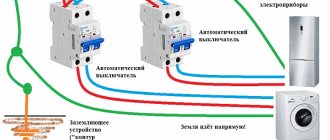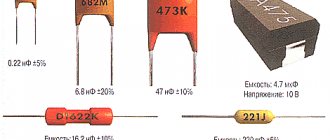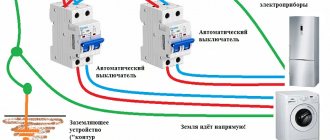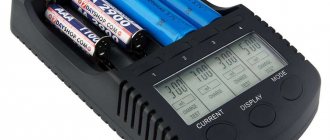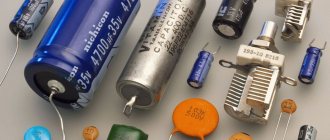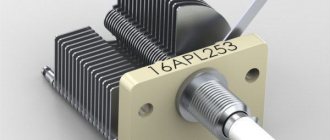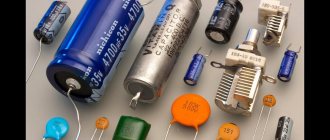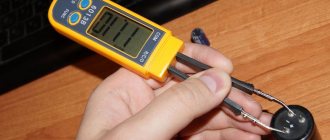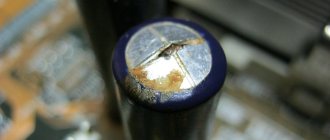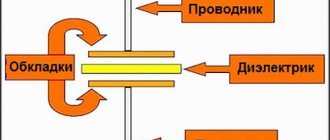According to their main characteristics, supercapacitors differ significantly from simple conventional capacitors. They use modern technologies that make it possible to achieve an increase in service life and also reduce current losses during operation. The main task of manufacturers of these devices is to develop and create products that can replace batteries in many industries.
Application of electrical double layer
For a long time, electrolytic capacitors had high internal capacitance values. In various devices, various plates were made, in some they were made of metal, in others in the form of an electrolyte, where the insulation was the oxide of the metal used. Moreover, with ordinary capacitors the internal capacitance is much lower and equal to fractions of a farad, which in practice is not enough to power consumers instead of batteries.
To provide power to electrical consumers, devices based on the use of a double electric field have been developed. This phenomenon can occur at the boundaries of a material or substance under certain conditions in a liquid or solid state. As a result, two layers of oppositely polar ions of the same size are formed, a kind of capacitor with electrodes is obtained, between which a minimum distance equal to several atoms is formed.
Interesting to know! Devices obtained in this way are called ionistors, as well as supercapacitors or ultracapacitors.
Development prospects
Mass production of hybrid public transport is expected in the near future. These are trolleybuses that will be able to cover sections of roads without trolls using power from on-board ionistors. They will be able to maneuver in places where the booms would be an insurmountable obstacle to traffic.
Scientists around the world are searching for new materials to create especially powerful supercapacitors. Such ionistors could completely replace traditional batteries.
Technical implementation
An ionistor or supercapacitor is a device whose design contains two electrodes or plates made of activated carbon. The space between them is filled with a special electrolyte; there is also a membrane between the plates, thanks to which the electrode particles do not move, and the electrolyte freely penetrates into this space.
Moreover, it is worth noting that these devices do not independently determine the polarity of the charge of specific electrodes. This property is one of the main differences from electrolytic capacitors, in which failure to properly connect them led to premature failure. However, during production, ionistors are marked with polarity, as a result of the fact that during the production process these energy storage devices are already charged.
DIY ionistor
To make a supercapacitor at home you will need:
- foil from a pack of cigarettes (dielectric);
- activated carbon tablets (electrode);
- water-soluble acrylic varnish or PVA glue (electrolyte).
You can make a homemade ionistor as follows:
- Cut out 2 rectangles from foil.
- Coal tablets are ground in a mortar to a fine powder. This can also be done in a coffee grinder.
- Charcoal powder is mixed with acrylic varnish.
- The resulting mixture is applied with a brush to one of the pieces of foil.
- After drying, a second layer of carbon is applied, then the process is repeated.
- Using PVA glue, glue the second rectangle of foil. The supercapacitor is ready.
- By connecting the wires to two opposite sides of the product, you can charge the ionistor using any battery.
DIY supercapacitor
Scientific and technological progress in creating perfect sources of electricity does not stop for a second. In the near future, high-quality high-voltage supercapacitors will be created, which will make a technological revolution in almost all areas of human activity.
Types of supercapacitors
Currently, all ultracapacitors are divided into three main types:
- Double layer.
- Hybrid.
- Pseudocapacitors.
Double layer capacitors
These devices are a product in the design of which electrodes are used with the presence of pores coated with carbon of increased conductivity; a special separator is located between them. Due to the separation of charges on the electrodes, a significant potential value is formed, resulting in the accumulation of energy.
Interesting to know! The value of the capacitance is directly affected by the value of the double layer.
The double layer in this design acts as a surface capacitor. Thanks to the electrolyte, the two layers are combined into a series chain.
Hybrid supercapacitor
This type of energy storage is considered intermediate between batteries and capacitors. The design of such devices uses electrodes made of different materials, as a result of which the charge capacity is accumulated in different ways.
The process of charge restoration itself occurs due to a redox reaction. This design allows you to significantly increase the internal capacitance and increase the operating voltage. Electrodes consist of a compound of complex conductive polymers, which, when combined, represent a material with increased electrical characteristics.
Pseudocapacitors
These devices are products somewhat similar in their basic characteristics to batteries; they have two solid electrodes.
As a result, it became possible to use a capacitor instead of a battery. The operating principle consists of two main mechanisms:
- charge-discharge operating cycles;
- electrostatic reactions that are observed in double layer devices.
Interesting to know! The capacity of pseudocapacitors depends on the reactions of electrolytic charge transfer.
Main settings
The main characteristics of a supercapacitor include:
- charging time has a small value and is equal to from 1 s to 10 s;
- in comparison with acid batteries they have a significant number of operating cycles, almost more than 30,000 hours;
- rated operating voltage is up to 2.75 V;
- service life up to 15 years;
- operating temperature range from -45°С to +65°С;
- Specific energy intensity is up to 5 W*h/kg.
Energy density
The ability of ionistors to accumulate energy is lower than that of acid batteries. The energy value depends on the internal resistance of the device; the lower it is, the higher the energy density. Modern developments make it possible to use materials such as nitrogen and graphene, thanks to which it has been possible to achieve a significant increase in internal energy density.
Accumulated energy
The amount of energy stored in a capacitor, expressed in joules:
E = CU2/2, where C is the capacitance, expressed in farads, U is the voltage on the plates, expressed in volts.
The amount of energy stored in the capacitor, expressed in kWh, is:
W = CU2/7200000
Hence, a capacitor with a capacity of 3000 F with a voltage between the plates of 2.5 V is capable of storing only 0.0026 kWh. How does this compare to, for example, a lithium-ion battery? If we take its output voltage to be independent of the degree of discharge and equal to 3.6 V, then an amount of energy of 0.0026 kWh will be stored in a lithium-ion battery with a capacity of 0.72 Ah. Alas, a very modest result.
Advantages and disadvantages
Like any electronic device, ionistors have some advantages and disadvantages during operation. The advantages of manufacturers include:
- They have a reduced specific cost when comparing the capacitance of a capacitor and a battery.
- Increased internal capacity, resulting in an increase in the number of charge-discharge cycles.
- More reliable and also have a longer service life, unlike acid and lithium batteries.
- They are environmentally friendly due to the materials used.
- Increased power ratings.
- Possibility of operation in a wide temperature range. Low temperatures are not a hindrance when starting up any type of equipment.
- Significantly increased time period during charge replenishment and during operating discharge.
- Unlike rechargeable batteries, they have the ability to be completely discharged to almost zero operating voltage.
Interesting to know! Supercapacitors are relatively small in size compared to other similar devices.
However, while there are many advantages during operation, there are also disadvantages. The disadvantages include:
- Low density of energy storage relative to similar devices.
- Reduced voltage value per unit of internal capacity of one element.
- Increased self-discharge reading.
- Not fully developed ionistor production technology.
Features of application
Ionistors have gained wide popularity thanks to mankind’s desire to find new and more effective means of accumulating and storing energy for a long time. The main advantage that determined its spread was the ability of a supercapacitor to pulsely release significant energy from 0.1 s to 10 s in a short period of time.
Ionistors have found application in installations and equipment where fast and high-quality startup of electrical equipment is required in a short period of time, even at subzero temperatures. This reduces the maximum current load and leads to cost savings. It is also possible that it can be used to start an internal combustion engine.
By connecting capacitors into a battery, it is possible to achieve a maximum capacity comparable to a battery for powering electric vehicles. However, the weight of the power source will be significantly higher than that of conventional batteries. The developers have practically managed to solve the problem of excess weight; this requires graphene; however, this is only possible in laboratory conditions.
Currently, one of the most successful applications of ionistors is their use in public electric transport. The design of such equipment uses uninterruptible power supply devices that contain supercapacitors.
Emergency lighting that uses high-capacity capacitors instead of batteries has a significant advantage over systems with conventional batteries.
Interesting to know! Some foreign manufacturers integrate backup power supplies based on ionistors into LED lamps.
Experiments
We will conduct experiments on a Kalina with a 1.6 engine, 16 valves. When the ionistors are charged to 16 volts in the summer, a cold engine starts easily. When warmed up, it starts even at 14 volts. In winter, at a temperature of -11, it started up just as successfully, but with difficulty. There have been cases where it won’t start on the first try; for the second attempt, you need to wait 1.5 minutes while the ionistors are charging. But on the second try it always starts. With a new standard battery, in any frost the car started on the first try.
Now, in winter, the battery from the UPS has died, either it is simply not designed to work in the cold, or they initially gave it to me barely alive. It’s not even enough to retract the starter, but it charges the ionistors. I ordered 4 LiFePO4 batteries and a balancer.

